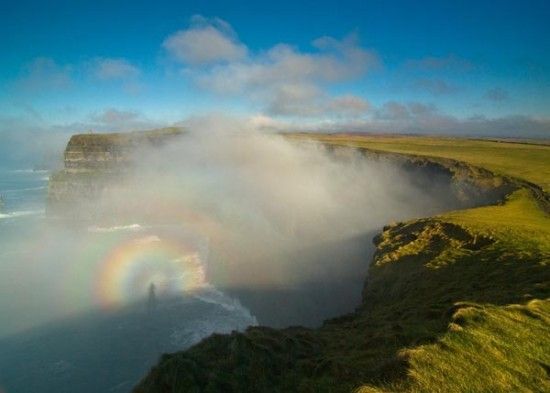Have you ever seen the like!? A "Brocken Spectre" looms over the Atlantic Ocean waters at the Cliffs of Moher. What a special sight!
The image above was snapped by one of our readers, Sean Tomkins, at the Cliffs of Moher, in County Clare. As well as catching the natural beauty of the cliffs, the photograph shows a rare natural optical event called a "Brocken Spectre".
This is defined as "a magnified shadow of an observer, typically surrounded by rainbow-like bands, thrown on to a bank of cloud in high mountain areas when the sun is low" by the Oxford dictionary.
The Cliffs of Moher are the most visited natural attraction in Ireland. Back in 2015, the Country Clare national attraction was also voted as having the best 'cliff-view' on the planet by Conde Nast Traveler. What better reasons to visit a place than stunning views and the recommendations of over 1.5 million visitors annually.
The Cliffs of Moher’s height reaches 214 meters (702 feet) at their highest point at Knockardakin just north of O’Brien’s Tower. At the southern end of the Cliffs of Moher stands Hags Head a natural rocky promontory, which is said to resemble a seated woman when viewed from the north.

Are you planning a vacation in Ireland? Looking for advice or want to share some great memories? Join our Irish travel Facebook group.
It’s little wonder so many travelers visit the 5-miles of coast on the Wild Atlantic Way which offer dramatic views of the ocean that will take your breath away.
The viewing platform at O’Brien’s Tower is said to be the best place to see the sunset if you’re lucky enough to visit in the evening. The Tower was built at the highest point on the cliff edge in 1835, as an observation point for tourists, by far-sighted landowner Cornelius O’Brien.
Before arriving at O’Brien’s Tower, you could try a guided walk along the cliff paths with a Cliffs of Moher Ranger. The walks take just over an hour and, depending on the time of year, you’ll see puffins, guillemots, kittiwakes, chough, peregrine falcon, fulmar, and shags, among other birds.
Enjoy.
Read more
* Originally published in 2013.




Comments